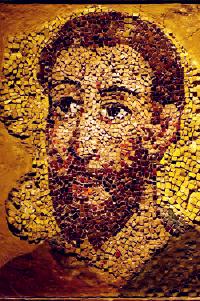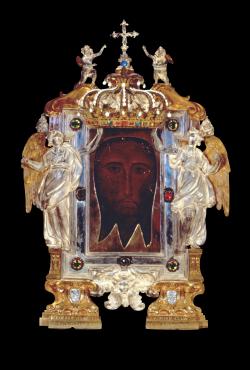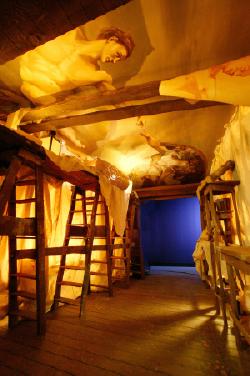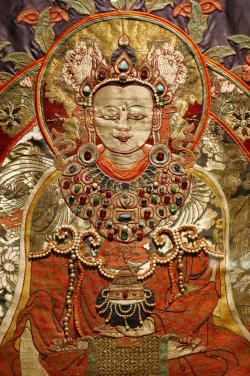|
Issue Date: March 12, 2004 History and homage Papal art exhibition showcases centuries of treasure By EILEEN CARR Promoting an exhibition -- or anything, really -- as a “once-in-a-lifetime opportunity” is sure to inspire skepticism, especially in our jaded, seen-it-all culture. But “Saint Peter and the Vatican: The Legacy of the Popes” is truly a remarkable opportunity for Americans to glimpse some of the spectacular glitter of one of Western culture’s most remarkable institutions. The exhibition is on view at the Cincinnati Museum Center, whose lower level galleries now abound with visually stunning objects crafted of gold and silver, pearls and precious gems, lace and silk embroidery. There are more than 300 items, most of them original works that together span nearly two millennia. Drawn from several different institutions from the Vatican’s vast collecting enterprise, many of these objects had never previously left Rome. A classic example of the grandeur on view is the papal tiara of Pope Pius VII, which is crowned with one of the world’s largest emeralds. The story of the tiara, however, is nearly as compelling as the size of this rare stone. Although the emerald dates back to the 16th century (used first for the tiara of Pope Julius II), it was seized by Napoleon in 1797 and subsequently reset into this new design. Although given back as a gift by Napoleon to Pius VII, it seems some mockery was intended, for the narrow circumference of the base made it impossible for the tiara to be worn.
Every gallery presents equally arresting works: There are elaborately embroidered copes, miters and even papal slippers; stunning chalices, monstrances and reliquaries worked from precious metals; and beautiful, often ancient, mosaics and fresco fragments. Awe and wonder are inspired at every turn. This was, of course, the hoped-for result. Fine craftsmanship and materials help “to make the things set apart for us in divine worship worthy, becoming and beautiful,” and as such they become “signs and symbols of supernatural realities” (Vatican Council II, Constitution of the Sacred Liturgy). Their beauty should remind us of the preciousness of God. Of course, such opulence may also inspire some discomfort (and indeed, the vows of poverty that some religious orders take make this all seem quite inappropriate). Sensibly, Saint Peter and the Vatican is more than just a medley of wonders from the papal collections. The organizers of the exhibition (Art Services International, Alexandria, Va., in conjunction with several offices of the Vatican) have constructed an exhibition -- and an impressive 500-page catalog ($40) -- with a good deal of substance. Together they tell the tale of the papacy itself and its changing focus through the centuries. They begin, of course, with Peter. “You are Peter and on this rock I will build my community” (Matthew 16:18). These words provide the basis of the church, the papacy and this exhibition. The message is gently reinforced for visitors through a variety of means: a short orientation video, the traditional wall and object labels, and a helpful audio tour (included with admission). That Peter was the first revered leader of the church is further illustrated by the focus in the first galleries on St. Peter’s Tomb. Legend has it that the tomb of St. Peter lay beneath the renaissance basilica of St. Peter’s, which in turn was constructed on the site of an old basilica ordered by Constantine in the fourth century. In the middle of the 20th century, secret excavations beneath the great baldachino of St. Peter’s led to the discovery of a second-century funerary monument. Beneath the simple marble construction are several ancient graves (the monument would have been constructed about a century after Peter’s execution in 65 in nearby Nero’s circus). Beside the marker is a wall that bears the third- and fourth-century “graffiti” of the faithful who came to pay their respects to Peter. This and other evidence suggests that the long-standing legend of St. Peter’s resting place has its basis in fact. Naturally, the tomb and monument cannot be moved; we can view only a reproduction. It is an unassuming beginning for visitors, who walk through a dimly lit and eerily quiet recreation of a second-century necropolis.
The simplicity of St. Peter’s original tomb fades quickly as visitors are led through time into galleries that document how this sacred site was subsequently developed. Although it is clearly impossible to give a real sense of the glorious and impressive spaces of the two basilicas built on Vatican Hill (as it was so named by the Romans), the exhibition provides some wonderful models and prints of both buildings. Especially intriguing is the documentation of the moving of the great Egyptian obelisk that sat in the middle of Nero’s circus. By the Middle Ages, the obelisk had become a revered symbol, as St. Peter and many martyrs had died in its shadow in the early days of Christianity. It seemed logical to move it into the center of the great plaza in front of the new St. Peter’s, but it was a gargantuan undertaking. A number of wonderful engravings bring the enterprise to life: Several scenes seem to depict every one of the 900 men and 150 horses needed to move the 330-ton obelisk. While the architecture of Vatican Hill provides some framework for the papal story, the most compelling aspects of the show are certainly the original works of art on view. One of the stars of the show is the famous Mandylion of Edessa, believed to be one of the earliest (perhaps the very oldest) representations of Jesus. Mandylion means “holy towel,” which refers to one of the legends about the origin of the image. Some held that Jesus miraculously left his image on a cloth pressed to his face (like the handkerchief of Veronica), but science tells us that this is indeed a man-made work, probably of tempera on linen. The image itself is quite small and darkened with age, but the grand silver frame, ornamented with a lavish crown above Christ’s head, proclaims past generations’ adoration of this mysterious work.
Another kind of adoration is evoked by the great artists of the past, and this exhibition includes a few works by two of the greatest names, Michelangelo and Bernini. Be forewarned: These are modest examples by these artistic giants, especially in the context of the many and massive works they created for the Vatican. Still, they are wonderful to see. The deft strokes on paper by Michelangelo, defining tiny but muscular figures, communicate a sense of the coiled energy typical of his work. Bernini is represented by a small but lovely clay modello (preparatory model) created for Urban VIII’s tomb. Still seeming fresh and immediate (even his fingerprints are visible in the hardened clay), the figure of Charity surrounded by several plump putti is animated by Bernini’s typical swirling dynamism. It may be easy to miss Michelangelo’s drawings, but a recreation of the scaffolding he used to paint the Sistine ceiling is a crowd-stopper. With an unfinished reproduction of the central scene -- the creation of Adam -- above their heads, visitors can experience something of what the artist may have experienced as he labored for four years to paint the ceiling. Flickering lanterns illuminate the small standing-room-only space, which is littered with ladders, brushes and containers of paint and plaster. Even several cartoons (large drawings), used as guides in creating the final frescoed version, are recreated; they rest curled above our heads as if the assistants have just left the platform for a break.
The Sistine Chapel is woven into the exhibition because it is the place where, since its construction in the 15th century, new popes have been elected. This process, and the subsequent coronation of a pope, is wonderfully documented with old film footage, as well as many artifacts. Significantly, one object that is not on view is the tiara of Pope Paul VI, who was the last pope to be crowned with one. At his request, and in keeping with the new culture established by Vatican II, his jeweled tiara was sold and the proceeds given to the poor (it is now housed in the Basilica of the Immaculate Conception in Washington). In a similar vein, Pope Paul VI left behind the more ostentatious crosiers of past leaders (some wonderful examples are on view) in favor of a simple pastoral staff topped by the crucified Christ (this, too, is on exhibit). This renunciation of some of the pomp and circumstance of the papacy is one of the last “lessons” of this exhibition. As one of the didactic panels states, in the modern era “the popes … have sought to create a more responsible relationship between the church and the world.” And so, on view are many fascinating documents of papal dialogue with leaders in all parts of the world. Most arresting is a gift from the 14th Dalai Lama. This silk thanka, a vividly embroidered image typically contemplated by Tibetan Buddhists, was intended as a gesture of homage. Indeed, Saint Peter and the Vatican might be viewed not only as a history of the papacy, but as homage, as well. It takes a reverential but reasonable view of one of the longest and most influential institutions of the past two millennia. Naturally, it skirts the many darker and more controversial aspects of this history, but the result is not a bad one. As the church intuitively understood long ago, beauty will always have the power to uplift us. Formerly the director of education for The Dayton Art Institute, Eileen Carr now works as a freelance arts writer and instructor.
National Catholic Reporter, March 12, 2004 |



